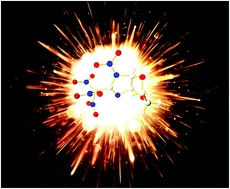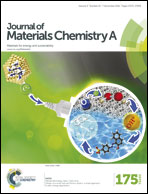1-Nitro-2-trinitromethyl substituted imidazoles: a new family of high performance energetic materials†
Abstract
A new series of 1-nitro-2-trinitromethyl substituted imidazoles were designed and synthesized. All the compounds were characterized by multinuclear NMR and IR spectroscopies, elemental analysis (EA), and differential scanning calorimetry (DSC). X-ray structure determination of compounds 11–15, 17 and 19 showed that their densities range from 1.59 g cm−3 to 1.86 g cm−3 and gave insights into their structural characteristics showing the presence of extensive hydrogen-bonding interactions. Most of these new materials exhibit positive heats of formation (HOF = 145.7–344.8 kJ mol−1), acceptable oxygen balances and sensitivity values (IS = 10.4–32.5 J, FS = 85–240 N). Detonation velocities (D) and pressures (P) were calculated with EXPLO5 V6.01 based on the calculated HOF and densities indicating that some of these trinitromethyl materials (D = 8688–8764 m s−1, P = 34.4–35.1 GPa) are comparable to 1,3,5-trinitroperhydro-1,3,5-triazine (RDX, D = 8795 m s−1, P = 34.9 GPa). Among the new derivatives, 17 (ρ = 1.82 g cm−3, ΔHf = 145.7 kJ mol−1, D = 8764 m s−1, P = 35.1 GPa, IS = 14.5 J, OB = 5.0%) shows potential as a high performance energetic material.



 Please wait while we load your content...
Please wait while we load your content...